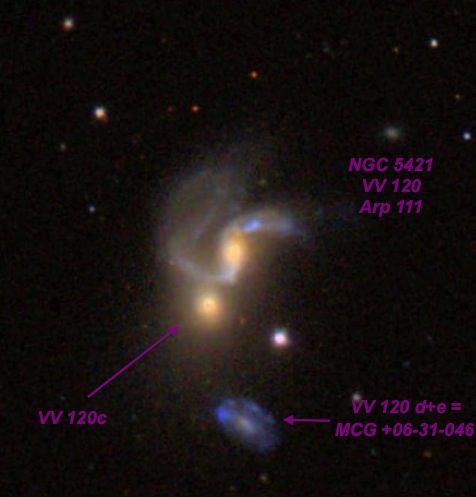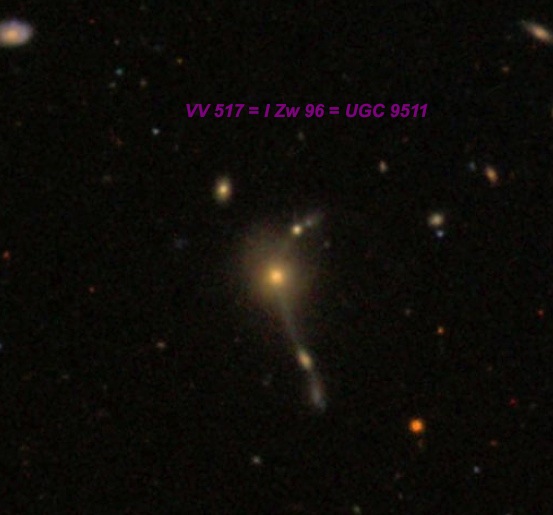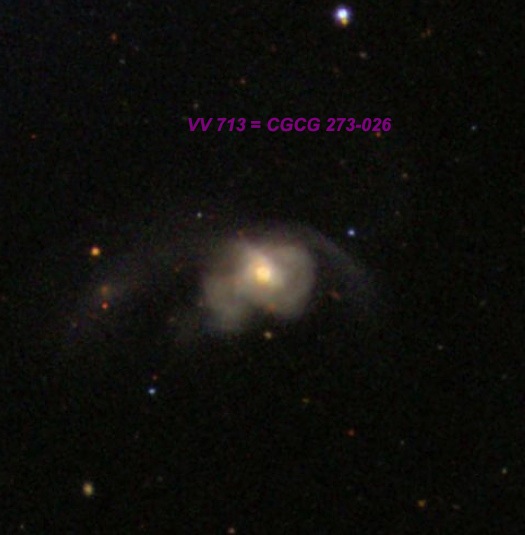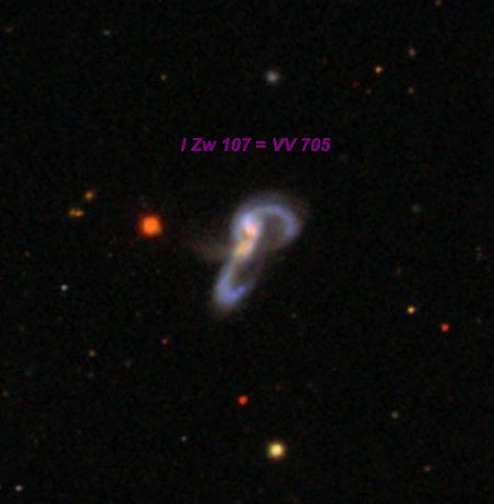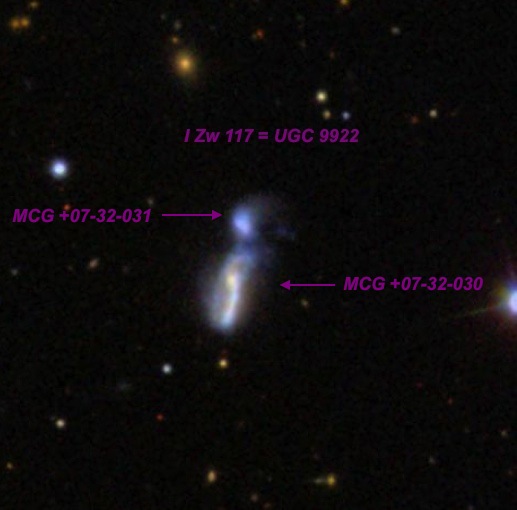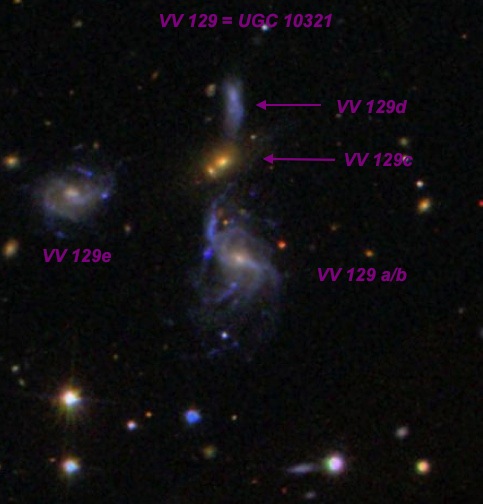|
|
VV 120 = Arp 111 = NGC 5421
14 01 41.4 +33 49 35
At 282x, this interacting pair appeared moderately bright, fairly small, elongated 3:2 NNW-SSE but irregular. Contains a very small, bright nucleus. A non-stellar knot
companion (VV 120c) appearing like a second bright "nucleus" was visible at the southeast end of the halo. At 322x, VV120c was easily resolved and appeared faint to fairly
faint, very small, round, 10" diameter. A mag 15 star is just off the southwest side. MCG +06-31-046 = VV 120d+e at mag 17.1V, is just 1' S of the pair and was glimpsed
several times for brief moments and confirmed at 322x. |
|
|
|
I Zw 96 = VV 517 = UGC 9511
14 44 53.6 +51 20 28
V = 15.3 B = 16.0
At 280x and 375x appeared very faint, very small, round, low even surface brightness, 15" diameter. Can just hold steadily with averted and concentration. 2MASX
J14450375+5121557, situated just 2.1' NE, was not seen. CGCG 273-026 = VV 713 lies 16.5' NNE and ?1871, a perfectly matched 1.8" pair of mag 8 stars, lies 31' WNW. Described by
Zwicky as a "Red post-eruptive globular compact with extended halo, pencil jets and associated faint stellar knots. |
|
|
|
VV 713 = CGCG 273-02614 45 45.1 +51 34 51
V = 13.8 B = 14.6
At 282x appeared fairly faint, small, slightly elongated, ~20"x15", very small brighter nucleus increases to the center, fainter halo. Situated midway between mag 8.6 HD
130370 3.4' NE and a mag 11 star 3.3' SW. I Zw 96 = VV 517 lies 16.5' SSW. On the SDSS this appears to be a possible merged system with tidal tails to the west and east,
although only one nucleus is visible |
|
|
|
I Zw 107 = VV 705 = CGCG 221-050
15 18 06.3 +42 44 36
At 282x this tight interacting pair appeared fairly faint, fairly small, oval 3:2 NNW-SSE, ~20"x14". A very small brighter nucleus appears offset to the east side of the glow. A
mag 15.8 star lies 35" ENE and a mag 16.0 star is 1.3' S. Located 14' NE of mag 7.5 HD 136115. On the SDSS there is a tight pair of nuclei, separated by only 6" and this object
appears to be a merging pair of compacts with tidally distorted arms that loop and intersect each other. |
|
|
|
I Zw 117 = UGC 9922
15 35 53.7 +38 40 40
At 322x this interacting pair of compact galaxies was just resolved. The brighter (starburst) component is on the south end and appeared fairly faint, fairly small, elongated
N-S, ~24"x12", contains a very small brighter nucleus offset towards the north end. A very faint, extremely small companion is barely detached in steady moments at the north
end, appearing as an 8" round knot. Generally, though, the two objects blend together into a single elongated glow. |
|
|
|
VV 129 = UGC 10321
16 18 05.3 +21 33 13
At 282x, three components of VV 129 were resolved. VV 129a = UGC 10321 NED01, the brightest member, appeared very faint, small, round, 18", visible continuously. VV 129c, just
35" N, appeared extremely faint, small, round, 10" diameter. VV 129e = MCG +04-38-047 lies 1.1' NE and appeared extremely faint (V = 16.2), very small, round, 12" diameter.
Could not hold continuously but repeatedly seen and confirmed. A quartet of mag 14-15.5 stars (similar size to VV 129) is less than 2' S. CGCG 137-077 lies 10' E and 2MASX
J16180582+2128229 is 5' S. |
|
|
|
|
VV 560 = UGC 10402
16 28 41 +12 45 57
At 282x appeared as a faint, elongated glow with a brighter elongated knot oriented N-S on the south side. The fainter northern component occasionally resolved into a very
faint, very small glow, ~10" diameter. VV 560 is an interacting pair of disturbed spirals. On the SDSS, the pair has a "Sickle" shape, with the fainter curved section at the
north end and the elongated "handle" at the south end.
|
|
|
|
I Zw 199
17 50 05.1 +56 40 27
At 320x, I Zw 199 appeared as a fairly faint, fairly small, round, irregular glow, ~30"x20" SW-NE with a small "knot" at the southwest end. Occasionally, a very close pair of
compacts were resolved. The northeast compoment (MCG +09-29-040) was larger (~20") and brighter (V = 14.7). The fainter southwest knot (MCG +09-29-039) was only 10"-12" in size
and more sharply defined. The centers of these compacts are separated by only 20"! |
|
